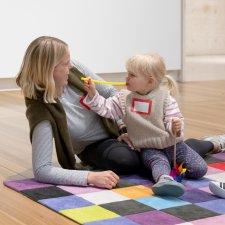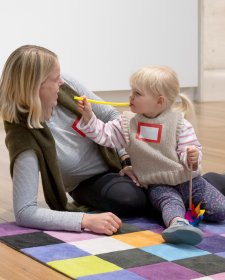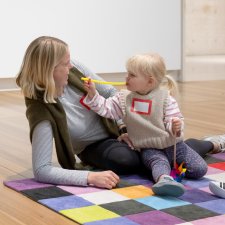The Hon. Michael Kirby AC CMG interviews the artist who painted his portrait, Ralph Heimans.
This video was produced with funds donated by Tim Fairfax AC.
The Hon. Michael Kirby AC CMG interviews the artist who painted his portrait, Ralph Heimans.
This video was produced with funds donated by Tim Fairfax AC.
Ralph Heimans: So basically, the first time we met it was sort of an initial meeting of the minds …
Michael Kirby: Meet and greet.
Ralph Heimans: Meet and greet. Then … and in which I asked you some important questions, and one of them was ways in which you might be represented. I sort of asked you what your hobbies were, or what your interests were.
Michael Kirby: Well, that would have drawn a bit of a blank.
Ralph Heimans: Well, you just said “work”. So I thought, “Okay, work.” So I pictured you immediately from that moment on in a work context, and previously I thought maybe take you out of the robes and … but that wasn’t going to work after having met you, and you had very strong sort of views on that.
The way I recall it, we had three hours to do the drawing, and it was a … I was impressed how still you were, and you were telling me that that was a …
Michael Kirby: That’s what judges are supposed to be.
Ralph Heimans: That’s what judges … exactly. But also, I actually remember it to be a very important day for you. I found out later, and was very … I felt very honoured that you had sort of given me your time.
Michael Kirby: My recollection is that I was actually doing some work whilst you were doing the sketches, and every now and again you would say, “Look up,” and if you …
Ralph Heimans: Is that right? Yes, that actually rings a bell, yeah.
Michael Kirby: If you look at the portrait, and if you look at the sketch, you will see I have a mild attitude of irritation.
Ralph Heimans: Well, I think you’re right, because actually that is also the impression I wanted to give in the painting, that you had somehow glanced at the viewer. So you’d turned … because you are turning, so that was always meant to be the sense of the painting, to have sort of a spontaneous feeling that you’d just turned towards the viewer to look at them.
Michael Kirby: “Who are you?”
Ralph Heimans: Exactly. Intruded on their conversation.
Michael Kirby: It was your idea, I believe, to portray the long-since-dead first President of the Court of Appeal, Sir Gordon Wallace …
Ralph Heimans: Yes.
Michael Kirby: … and the also-dead Sir Bernard Sugerman …
Ralph Heimans: That’s right.
Michael Kirby: … both of whom were very great judges, certainly especially Sugerman. And so you portrayed them in the portrait, and their families have since seen the portrait and been very happy about the portrayal of their fathers in it.
Ralph Heimans: Well, I think it’s a very … I think it was a powerful idea, because the main … the ambition was to represent you in the line of judges wearing the crimson and fur, as of the line … from the line in your speech. And it was important, I think, to show the line being that of Presidents of the Supreme Court. I think there was … that lineage was the one that was important to communicate.
Michael Kirby: Being a child of photography, it was an odd idea to me that I was being portrayed with judges with whom I had never sat, who were very much older than I and who were dead. But the composition evolved, and I think on the whole it was very creative. The title, Radical Restraint, I’d like to know what you think whether there’s more radical or more restraint in my portrait, and where did the title come from?
Ralph Heimans: Okay. The title was meant to draw attention to some of the themes that I was trying to bring out in the painting. It actually was the creation of my brother, who was a law student at the time. But basically it was meant to describe something about your particular judicial approach, but also to draw attention to some of the themes of the painting. So the word “radical” was meant to draw attention to your progressive judicial approach, and in the painting that is represented by the fact that you are the only judge without a wig, and that you are gazing to …
Michael Kirby: I’m not without a wig. I hold the wig. I haven’t put it on it.
Ralph Heimans: Without a wig on your head. Exactly. And that you’re gazing directly at the viewer, so you’re addressing the viewer in the way that the other judges aren’t. Most of them have their backs to the viewer, which might be symbolic of basically not having the interests of the public at heart. That might be a bit of a comment. But that might be … it’s not directly stated, it might be an insinuation.
Michael Kirby: Well, the different perception of what the law requires.
Ralph Heimans: Exactly.
Michael Kirby: And I’m not unhappy with the title myself. I think it does show you can be a liberal as a judge, but ultimately you’re bound by the law and therefore you’re under that restraint, so …
Ralph Heimans: Well, that’s the restraint, exactly. And the fact that you are … represent that, you are still in the line with the other judges, albeit you are a little bit sort of out of step to some extent, turned the other way, but you are still in the line. You’re still wearing what they’re wearing, and so that notion of judicial precedent and the importance of adhering to the tradition is something I wanted to convey as well in the painting.



Drop into the Gallery any time for free creative activities inspired by artist Thom Roberts and his exhibition, The Immersive World of Thom Roberts.



Join us for Portrait Play these school holidays as we explore portraits and music. Come and meet the people that live on our walls, discover musical instruments hidden in the portraits and get creative on your journey through the galleries.



Do we have a treat for the smaller humans in your life! Little Faces is for babies and toddlers (with their grown up) to play, sing and have fun discovering a portrait together.